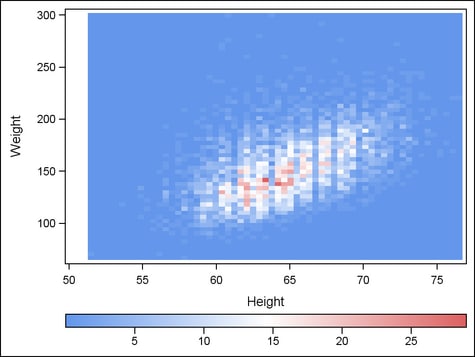Example Program and Statement Details
Example Program
proc template;
define statgraph heatmapparm;
begingraph;
layout overlay;
heatmapparm x=height y=weight colorresponse=count /
name="heatmapparm" xbinaxis=false ybinaxis=false;
continuouslegend "heatmapparm" / location=outside valign=bottom;
endlayout;
endgraph;
end;
run;
proc sgrender data=sashelp.gridded template=heatmapparm;
run;Statement Summary
A heat map is useful
for visualizing the magnitude of a response variable in relation to
two independent variables. For example, in molecular biology, heat
maps can be used to track the expression of genes across multiple
sample studies. In the HEATMAPPARM statement, you specify the independent
variables in the X and Y arguments. For a response variable that has
discrete values, use the COLORGROUP argument, or for a response variable
that has interval values, use the COLORRESPONSE argument. For interval
response variables, you can use the COLORMODEL= option to define the
color ramp that is used to fill the rectangles.
Arguments
specifies a column
that is used to discretely color the regions in the heat map. Required
when the response variable is of type discrete.
specifies
a discrete attribute variable that is defined in a DISCRETEATTRVAR statement.
specifies a numeric
column that is used to color the regions of the heat map. The colors
for each region are computed by mapping the values of this column
to a color ramp that is defined by the COLORMODEL= option. This argument
is required when the response variable is of type interval.
specifies
a range attribute variable that is defined in a RANGEATTRVAR statement.
Options
specifies a style element
to be used with the COLORRESPONSE= argument.
Default: The
ThreeColorRamp style element. The STARTCOLOR attribute represents
low response values and the ENDCOLOR attribute represents high response
values.
Name of a style element.
The style element can contain these style attributes:
| STARTCOLOR | Specifies a color for the smallest data value of the COLORRESPONSE variable. |
| NEUTRALCOLOR | Specifies a color for the midpoint of the range of the COLORRESPONSE variable. |
| ENDCOLOR | Specifies a color for the highest data value of the COLORRESPONSE variable. |
specifies the appearance
of the outlines of the filled rectangles. See General Syntax for Attribute Options for the syntax
on using a style-element and Line Options for available line-options.
Interaction: For
this option to have any effect, outlines must be enabled by the ODS
style or the DISPLAY= option.
specifies that the
data columns for this plot and the plot type be used for determining
default axis features.
Details: This
option is needed only when two or more plots within an overlay-type
layout contribute to a common axis. For more information, see When Plots Share Data and a Common Axis.
specifies
whether to reverse the gradient that is specified by the COLORMODEL= option.
specifies user-defined
roles that can be used to display information in the tooltips. Columns
for the tooltip display are specified in the TIP= option.
Requirement: The
role names that you choose must be unique and different from the pre-defined
roles X, Y, COLORGROUP, and COLORRESPONSE.
Interaction: For
this option to take effect, the TIP= option must be used to add the roles in the role list to
the tooltips.
specifies the information
to display when the cursor is positioned over a filled rectangle.
If this option is used, it replaces all the information displayed
by default. Roles for columns that do not contribute to the heat map
can be specified along with roles that do.
Default: The
columns assigned to these roles are automatically included in the
tooltip information: X and Y, and COLORGROUP or COLORRESPONSE.
Requirement: To
generate tooltips, you must include an ODS GRAPHICS ON statement that
has the IMAGEMAP option specified, and write the graphs to the ODS
HTML destination.
Interaction: The
labels and formats for the TIP variables can be controlled with the TIPLABEL= and TIPFORMAT= options.
specifies display formats
for information defined by the tooltip roles.
Default: The
column format of the variable assigned to the role or BEST6. if no
format is assigned to a numeric column.
Requirement: Columns
must be assigned to the roles for this option to have any effect. See
ROLENAME=.
specifies display labels
for information defined by the tooltip roles.
Requirement: Columns
must be assigned to the roles for this option to have any effect. See
ROLENAME=.
specifies whether data
are mapped to the primary X (bottom) axis or to the secondary X2 (top)
axis.
Interaction: The
overall plot specification and the layout type determine the axis
display. For more information, see How Axis Features Are Determined.
specifies whether to
use bins as the basis for X-axis tick marks. If this option is set
to FALSE, a standard axis is used, ignoring bin boundaries and midpoints.
Interaction:
If this option is set to TRUE, then the XENDLABELS= option determines how the axis ticks
and value labels are displayed. If this option is set to FALSE, the
XENDLABELS= option is ignored.
specifies whether the
axis ticks and value labels are drawn at the endpoints of the bins
or midpoints of the bins.
specifies whether the
X values represent lower endpoints, midpoints, or upper endpoints
of the bins.
specifies whether data
are mapped to the primary Y (left) axis or to the secondary Y2 (right)
axis.
Interaction: The
overall plot specification and the layout type determine the axis
display. For more information, see How Axis Features Are Determined.
specifies whether to
use bins as the basis for Y-axis tick marks. If this option is set
to FALSE, a standard axis is used, ignoring bin boundaries and midpoints.
Interaction:
If this option is set to TRUE, then the YENDLABELS= option determines how the axis ticks
and value labels are displayed. If this option is set to FALSE, the
YENDLABELS= option is ignored.
specifies whether the
axis ticks and value labels are drawn at the endpoints of the bins
or midpoints of the bins.
